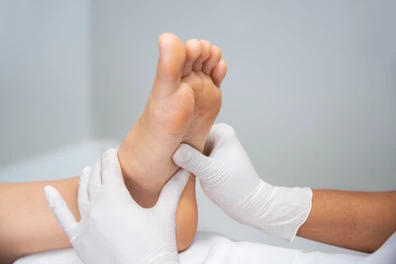Plantar Fasciitis or Plantar Heel Pain?
January 7, 2019
This time of year we find more patients are complaining of pain in their heel/s and/or the sole of their foot.
One explanation may be that we’re more likely to be barefoot or in thongs in the hotter weather.
Maybe you’ve heard of “plantar fasciitis” before? It’s a common diagnosis, and the name suggests the cause of the pain is inflammation of the plantar fascia, which is connective tissue in the sole of the foot.
However, recent research suggests that the plantar fascia may not be the cause of this pain. Rather, the pain is thought to arise from irritation of a nerve which supplies the foot. The researchers have suggested that we should call this condition “Plantar Heel Pain Syndrome”.
Why don’t they think the pain comes from the plantar fascia?
Three orthopaedic tests have been found to fairly consistently reproduce people’s heel pain, which do not cause stress to the plantar fascia. Further study found leg muscle tightness causing neural irritation was a more likely cause of the heel pain.
What does this mean for treating the plantar fascia?

Many treatments for heel pain, in isolation, do not have good quality evidence supporting their efficacy. However, physiotherapy treatment of heel pain, like almost every condition we treat, is multifaceted. Combinations of treatments have been shown to be effective.
This research improves our understanding of heel pain and offers additional assessment and treatment options to us as physiotherapists. The researchers suggest deep friction massage and stretches of the calf and other leg muscles, and activity modification as treatment for heel pain based on their research.
However, an individual patient’s treatment should always be based on that particular patient’s presentation. As such, your treatment for heel pain will be based on a thorough assessment of your presentation and may include massage, joint mobilisations, taping, neural sliders, dry needling, stretches, strengthening exercises and/or activity modification, and possibly other treatments as well.
So what do we call it?

You may not realise it, but there are many conditions that have multiple different names used interchangeably by health professionals. This can be confusing, but it’s just reality that you’re not going to get all the world’s health professionals and researchers to agree on what to call everything. So Achilles tendinitis is also called Achilles tendinopathy. Sub-acromial bursitis, sub-acromial pain syndrome and shoulder impingement all describe the same condition.
“Plantar Heel Pain Syndrome” seems a reasonable name for the condition (though it is a bit of an example of the diagnosis just repeating where the patient is reporting their pain. “You’ve got pain on the plantar aspect of your heel? That’s plantar heel pain.”).
The name we give a diagnosis is not as important as providing the patient with a good understanding of the cause of the pain, the contributing factors and what we’re going to do about it. So for now I’ll be using the diagnosis of “Plantar Heel Pain Syndrome”, explaining what it is and that it may also be called “plantar fasciitis”.
Are you suffering from pain in your heels and/or feet? Our physiotherapists today are completing their final continuing education session in a series of five on the topic. So there’s never been a better time to make an appointment with our physiotherapists to start treating your heel pain today!
-
 What Can Make Neck Pain a Headache?
What Can Make Neck Pain a Headache?
Often people experiencing a headache are also experiencing neck pain/tightness a...
-
 How Physio Can Help Your Headaches
How Physio Can Help Your Headaches
Headaches are no fun. Some people will only experience short-term headaches ever...
-
 Muscle Strains
Muscle Strains
Winter sports are back and with them come more muscle strains, particularly hams...
